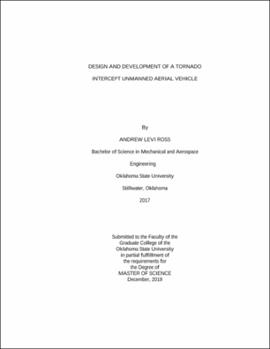| dc.contributor.advisor | Jacob, Jamey | |
| dc.contributor.author | Ross, Andrew Levi | |
| dc.date.accessioned | 2020-06-29T17:39:19Z | |
| dc.date.available | 2020-06-29T17:39:19Z | |
| dc.date.issued | 2019-12 | |
| dc.identifier.uri | https://hdl.handle.net/11244/324908 | |
| dc.description.abstract | Very little data surrounding tornado genesis exists, and this is due in part to the lack of tools necessary to deliver weather-sensing instruments into the severe weather phenomenon. Though current UAS are able to accurately gather weather data, they typically cannot operate in high winds or in rain. To help bridge this data gap, a custom delta wing UAS was developed to withstand both of these shortcomings. | |
| dc.description.abstract | The aircraft was outfitted with an autopilot, long range RC control, and FPV systems for control over long distances. Despite utilizing a new turbojet that generates 50% more thrust at the cost of a 50% increase to fuel consumption, custom fuel tanks were designed and fabricated double the flight time of the previous system. Considerations for preventing ingested water from damaging internal avionics are explored, as operation in rain is a requirement. | |
| dc.description.abstract | Aircraft performance approximations were generated using both analytical approximations and flight test data from the autopilot's flight log. An approach to generating a longitudinal aerodynamic control model is explored to estimate performance in extreme winds (75+ mph), but ultimately fails due to lack of conventional horizontal tail and the coupling of pitch and yaw controls to the turbine's exhaust speed (controlled by throttle setting). | |
| dc.description.abstract | A car-based launcher system was also created for utilization in the field, reducing the required personnel's experience to execute a mission effectively. Multiple aircraft, as well as a prototype of the TIV, has launched successfully multiple times from this system, even exhibiting full auto-launching functionality. | |
| dc.description.abstract | The longest recorded flight was over a ground track of 22 miles with an average airspeed of 100 knots over 16 minutes, consuming 60% of the total fuel available. The top speed achieved by the aircraft was 160 mph at 90% throttle. | |
| dc.format | application/pdf | |
| dc.language | en_US | |
| dc.rights | Copyright is held by the author who has granted the Oklahoma State University Library the non-exclusive right to share this material in its institutional repository. Contact Digital Library Services at lib-dls@okstate.edu or 405-744-9161 for the permission policy on the use, reproduction or distribution of this material. | |
| dc.title | Design and development of a tornado intercept unmanned aerial vehicle | |
| dc.contributor.committeeMember | Arena, Andrew | |
| dc.contributor.committeeMember | Faruque, Imraan | |
| osu.filename | Ross_okstate_0664M_16591.pdf | |
| osu.accesstype | Open Access | |
| dc.type.genre | Thesis | |
| dc.type.material | Text | |
| dc.subject.keywords | aircraft design | |
| dc.subject.keywords | flight testing | |
| dc.subject.keywords | severe weather | |
| dc.subject.keywords | uas | |
| dc.subject.keywords | unmanned aircraft | |
| dc.subject.keywords | weather research | |
| thesis.degree.discipline | Mechanical and Aerospace Engineering | |
| thesis.degree.grantor | Oklahoma State University | |
